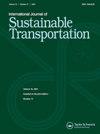自动驾驶车辆道路使用者脆弱行为估计研究进展
IF 3.9
3区 工程技术
Q2 ENVIRONMENTAL STUDIES
International Journal of Sustainable Transportation
Pub Date : 2025-06-03
DOI:10.1080/15568318.2025.2510413
引用次数: 0
摘要
近年来,车辆自动化支持系统的发展,重点是通过新的方法和技术来增强数字交通设施,得到了广泛的欢迎。然而,在实际应用中,已开发的自动化保障系统在安全性、有效性和可靠性方面并不完全兼容。大量有前景的研究强调了将弱势道路使用者(vru)行为方面整合到自动车辆系统中的重要性,这可能有助于提高安全性、有效性、可靠性和社区接受度。针对这一研究焦点,本文对自动驾驶车辆的VRU行为分析进行了全面的综述,特别是对VRU行为方面的相关研究进行了研究。我们回顾了73项研究,以解决一个研究问题:自动驾驶汽车的哪些方面需要注意,以提高虚拟驾驶车辆的安全性?本综述重点介绍了三个主要研究领域的研究成果:(I) vru穿越意图预测,(II) vru运动预测,(III) vru路径/轨迹预测,主要集中在十个关键方面:(i) vru上下文理解的改进,(ii)早期阶段检测和预测,(iii)计算/处理时间,(iv)一致/连续预测,(v)交互式导航,(vi)语义性,(vii)低尺度数据集,(viii)长期预测,(ix)实时预测,(x)可解释性改进。此外,它还解决了多个场景的观察困难、上下文信息的理解困难、群体行为的检测困难等问题,这对于提高未来自动驾驶汽车的可靠性和可接受性至关重要。本文的研究结果将为自动驾驶车辆驾驶辅助系统的开发提供新的思路和方向。本文章由计算机程序翻译,如有差异,请以英文原文为准。
A review on the estimation of vulnerable road user behavior for automated vehicles
In recent years, the development of automated support systems for vehicles, focusing on enhancing digital traffic facilities through new methods and techniques has gained immense popularity. However, in real-life scenarios, the developed automated support systems are not completely compatible in terms of ensuring safety, effectiveness, and reliability. A promising number of research have emphasized the importance of integrating vulnerable road users’ (VRUs) behavioral aspects into automated vehicle systems which might help to improve safety, effectiveness, reliability, and community acceptance. Addressing this research focus, this paper presents a comprehensive review focusing on VRU behavior analysis for automated vehicles, specifically examining studies related to VRUs’ behavior aspects. We reviewed 73 studies addressing one research question: What aspects of automated vehicles need attention to improve their safety for VRUs? This review highlights and represents the findings focusing on three major groups: (I) VRUs crossing intention prediction, (II) VRUs motion prediction, and (III) VRUs path/trajectory prediction, concentrating on ten key aspects: (i) Improvement of VRUs context understanding, (ii) Early phase detection and prediction, (iii) Computational/Processing time, (iv) Consistent/Continuous prediction, (v) Interactive navigation, (vi) Semanticity, (vii) Low-scale dataset, (viii) Long-term prediction, (ix) Real-time prediction, and (x) Explainability improvement. Besides, it also addresses several challenges, such as difficulties in observing multiple scenarios, understanding contextual information, and detecting group behavior, which is crucial for enhancing the reliability and acceptability of automated vehicles in future research. The findings of this review are significant to provide new insights and directions for developing driving support systems for automated vehicles by integrating VRUs behavior.
求助全文
通过发布文献求助,成功后即可免费获取论文全文。
去求助
来源期刊
CiteScore
8.90
自引率
2.60%
发文量
56
期刊介绍:
The International Journal of Sustainable Transportation provides a discussion forum for the exchange of new and innovative ideas on sustainable transportation research in the context of environmental, economical, social, and engineering aspects, as well as current and future interactions of transportation systems and other urban subsystems. The scope includes the examination of overall sustainability of any transportation system, including its infrastructure, vehicle, operation, and maintenance; the integration of social science disciplines, engineering, and information technology with transportation; the understanding of the comparative aspects of different transportation systems from a global perspective; qualitative and quantitative transportation studies; and case studies, surveys, and expository papers in an international or local context. Equal emphasis is placed on the problems of sustainable transportation that are associated with passenger and freight transportation modes in both industrialized and non-industrialized areas. All submitted manuscripts are subject to initial evaluation by the Editors and, if found suitable for further consideration, to peer review by independent, anonymous expert reviewers. All peer review is single-blind. Submissions are made online via ScholarOne Manuscripts.

 求助内容:
求助内容: 应助结果提醒方式:
应助结果提醒方式:


